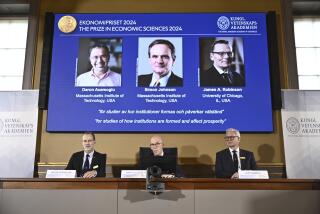Two Americans, Russian Awarded Nobel for Superconductor Work
- Share via
The Nobel Prize was awarded Tuesday to three physicists from the U.S. and Russia who explained the bizarre behavior of materials at the extremes of cold -- phenomena that have turned out to have a wealth of practical applications.
Anthony Leggett of the University of Illinois at Urbana-Champaign developed the theory explaining a perplexing form of helium that seemed to defy known laws of physics.
Alexei Abrikosov of Argonne National Laboratory near Chicago and Vitaly Ginzburg of the Lebedev Physical Institute in Moscow showed how superconducting materials, which conduct electricity friction-free, could sustain high magnetic fields, making possible everything from Magnetic Resonance Imaging to high-energy particle accelerators.
“They’ve had a big impact on the way everybody thinks,” said Princeton physicist Robert Cava. “These are the first things you learn in superconductivity school.”
Both effects reveal the hidden world of quantum mechanics to human eyes by making large groups of atoms behave as one. It is a physical world where friction doesn’t exist, making it irresistible for technology.
Superfluid helium, for example, is a liquid so unique it can flow up and out of bottles and down through the bottoms of ceramic containers. The reason is that at 2 degrees above absolute zero (minus 459 degrees F), the atoms get so chummy they move together like a line of Rockettes -- if a single atom moves, the others must follow.
The most common form of helium -- called helium 4 due to its two neutrons and two protons -- can condense into a superfluid because its even number of nuclear particles makes it compressible, like a “particle” of light that you can put your hand through. Helium 3, which has only one neutron, is unable to condense in that way because its odd number of nuclear particles makes it behave more like a chunk of stone.
At even colder temperatures -- a thousand times colder still -- it turns out that helium 3 can also become a superfluid -- one that was far more complicated than imagined.
Leggett discovered that helium 3 atoms could first clump into pairs that behave as one; those pairs in turn condense to create a superfluid with a multi-faceted structure. By comparison, “helium 4 is rather boring,” said the 65-year-old physicist, a native of London.
Leggett’s work was cited in the 1996 Nobel prize announcement for the experimental discovery of helium 3. “I’m almost as excited about this prize as I was about my own,” said Stanford physicist Douglas Osheroff, who won that year.
Superconductors were discovered in 1911 but proved initially disappointing. These early materials lost their ability to give electricity a friction-free ride under the influence of even modest magnetic fields. Since electric currents create magnetic fields, this made the materials all but useless for technology.
Almost 50 years ago, however, Abrikosov explained how a different kind of superconductor could stand much stronger magnetic fields.
The earliest superconductors allowed magnetic fields to penetrate a material. This created heat, which destroyed the friction-free state. Abrikosov, however, envisioned a situation in which the magnetic fields threaded through the material only in microscopic vortices -- in effect, protecting the superconductivity.
“At the moment when I wrote about it, no one believed such an object could even exist,” said the 75-year-old Russian-born scientist who now lives in the U.S. That didn’t bother him, however, “because my work is always a pleasure for myself.”
Unlike other laureates, who inevitably say they are surprised by the early morning call, Abrikosov knew he had been nominated for at least 10 years, so he wasn’t all that surprised by the 4:15 a.m. call. “After that, all this mess started,” he said genially, referring to the onslaught of reporters.
Ginzburg, reached in Moscow, said he thought the call from Sweden was a practical joke. “I did not expect it to happen like this,” said the 87-year-old physicist. “I expected some nosy reporter to call me first.”
Ginzburg laid the groundwork for Abrikosov’s discovery by elucidating the relationship between superconductivity and magnetism. Although Abrikosov worked in Moscow, he did not work with directly with Ginzburg.
The prizes were especially welcome in Russia, where a once-stellar scientific community has suffered enormous losses in prestige and people in recent years. Life is so hard and pay is so low for Russian scientists, said Alexei Gippius, deputy director of the Lebedev Institute, that young people are shunning the field. He hoped this might give them a needed boost.
The three will split the $1.3-million prize. In all, more than half a dozen physics Nobel prizes have been awarded for discoveries related to superconductivity. Abrikosov said he thought this might be due to Alfred Nobel’s directive more than 100 years ago that the discoveries honored have some practical purpose. “It’s very difficult to make a practical case for superstrings and parallel spaces.”
*
Times staff writer David Holley contributed to this report.






